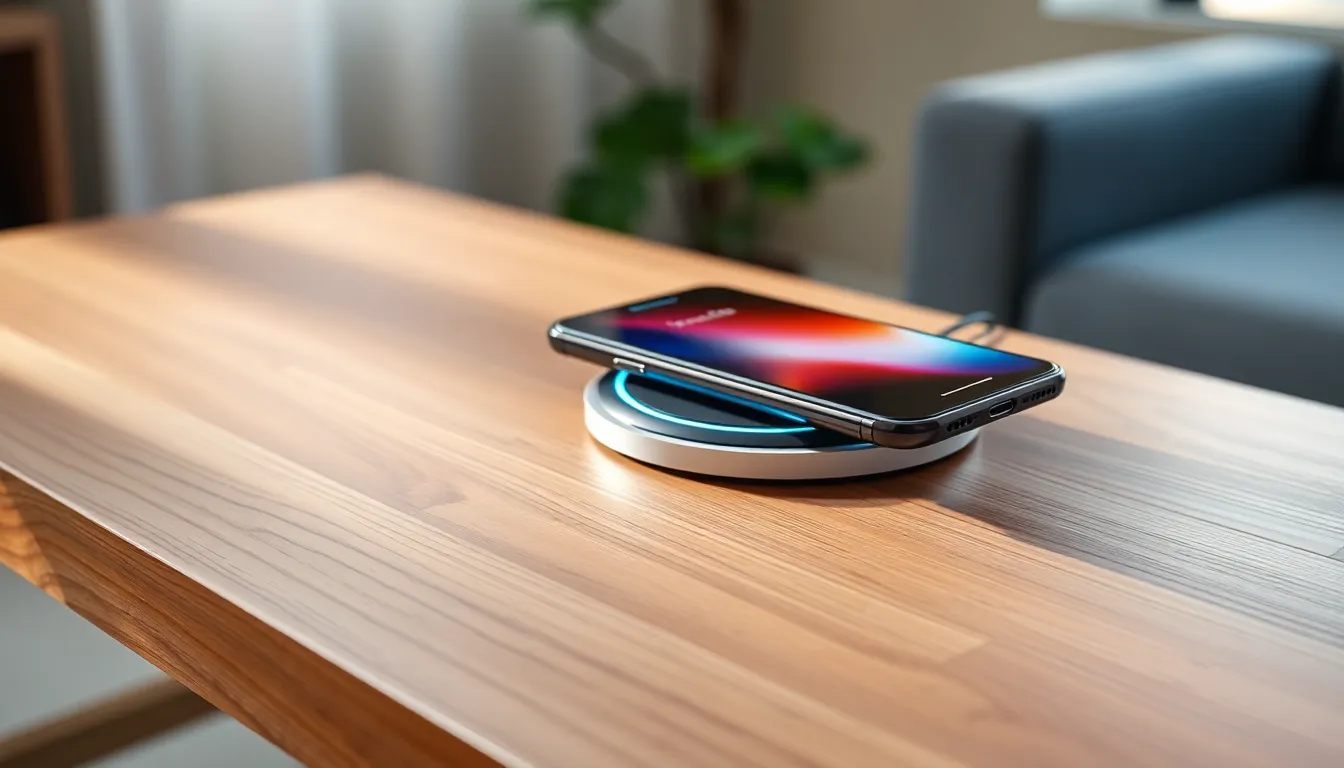In a world increasingly driven by convenience and innovation, wireless charging devices have emerged as a game-changer. These sleek gadgets eliminate the hassle of tangled cords and offer a seamless way to power up smartphones, tablets, and other electronics. As technology advances, more users are discovering the benefits of going cord-free, making wireless charging a staple in homes and offices alike.
The appeal of wireless charging lies not just in its simplicity but also in its versatility. With various designs and compatibility options, users can easily integrate these devices into their daily routines. As the demand for efficient charging solutions grows, manufacturers are continually enhancing their offerings, making it an exciting time for tech enthusiasts and casual users alike. Embracing this technology can lead to a more organized and efficient lifestyle, paving the way for a future where charging is as effortless as setting a device down.
Table of Contents
ToggleOverview of Wireless Charging Devices
Wireless charging devices utilize electromagnetic fields to transfer energy between a charging pad and a compatible device. This technology eliminates the need for physical connectors, simplifying the charging process for smartphones, tablets, and more.
Key Technologies
- Qi Standard: Qi technology dominates the wireless charging market, supporting a wide range of devices from various manufacturers. It operates at frequencies of 110-205 kHz, accommodating both small and large gadgets.
- Resonant Inductive Charging: This method allows charging over larger distances compared to traditional inductive charging. It can power multiple devices simultaneously, improving convenience and functionality.
- Radio Frequency (RF) Charging: RF charging uses radio waves to transfer energy. While still developing, it holds potential for applications beyond small electronics, including larger devices and electric vehicles.
Benefits of Wireless Charging
- Convenience: Users can simply place devices on the charging pad without worrying about aligning ports or cables.
- Reduced Wear and Tear: Eliminating physical connections minimizes damage to charging ports, extending the lifespan of devices.
- Versatility: Wireless charging pads can accommodate various devices, making them suitable for personal and shared environments, such as homes, offices, and public spaces.
Market Trends
Recent data indicates a growing demand for wireless charging solutions, projected to reach a value of $25 billion by 2025. Adoption is increasing in both consumer electronics and automotive industries. Brands are now integrating wireless charging capabilities into furniture and fixtures, further enhancing user experience.
Future Developments
Innovations in wireless charging technology focus on improving efficiency and charging speeds. Research aims to enhance the range of charging and develop universal solutions compatible with multiple device types. As manufacturers continue to refine these products, the potential for wireless charging to become a standard feature in everyday life increases.
How Wireless Charging Works

Wireless charging uses electromagnetic fields to transfer energy from a charging pad to a device, eliminating the need for physical connectors. This technology simplifies the charging process, making it efficient and user-friendly.
The Technology Behind It
Wireless charging relies primarily on inductive charging, which uses two coils: a transmitter coil within the charging station and a receiver coil in the device. When electricity flows through the transmitter coil, it creates an electromagnetic field. The receiver coil in the device captures this energy, converting it back into electrical power to charge the battery. This process allows for seamless energy transfer without direct contact between the device and the charging pad.
Different Standards and Protocols
Several standards and protocols govern wireless charging technologies, enhancing compatibility across devices.
- Qi: The most widely adopted standard, developed by the Wireless Power Consortium, supports smartphones, tablets, and wearables. It enables efficient charging at up to 15 watts for compatible devices.
- PMA: The Power Matters Alliance standard also supports wireless charging but has less market penetration compared to Qi. It focuses on interoperability among devices, particularly in public charging stations.
- A4WP: The Alliance for Wireless Power promotes resonant inductive charging, allowing devices to charge over longer distances. This protocol supports multiple devices simultaneously, providing flexibility in user setups.
- RF: Radio frequency charging extends the reach of wireless power beyond short distances, targeting small electronics and IoT devices. It shows potential in applications like powering sensors or smart home devices.
These standards facilitate the growth of wireless charging solutions, ensuring that more devices can benefit from this innovative technology.
Advantages of Wireless Charging Devices
Wireless charging devices offer significant advantages over traditional charging methods. They simplify the process of powering electronic gadgets and provide users with a streamlined experience.
Convenience and Ease of Use
Convenience defines wireless charging devices. Users can simply place their gadgets on the charging pad without aligning connectors. This feature eliminates the hassle of plugging and unplugging cables. Wireless charging stations support multiple devices simultaneously, accommodating smartphones, tablets, and wearables. Public spaces increasingly feature integrated wireless charging stations, enhancing access and usability in cafes, airports, and offices.
Safety Features
Safety features make wireless charging devices an attractive option. Many devices incorporate built-in mechanisms that prevent overheating, ensuring safe operation during charging. Smart technology detects foreign objects, disabling charging when any interference is detected. This functionality protects both the device and its user. Additionally, most wireless chargers employ low-voltage systems, reducing risks associated with electric shocks, making usage safer for daily interactions.
Disadvantages of Wireless Charging Devices
Despite their convenience, wireless charging devices offer several disadvantages that potential users should consider.
Speed Limitations
Speed limitations affect the efficiency of wireless charging devices. Charging times can significantly exceed those of traditional wired options. For example, a standard wireless charger may provide charging speeds of 5 to 15 watts, while wired chargers often reach up to 100 watts or more. The reduced power transfer can lead to longer wait times for fully charging devices. Users requiring quick charges, such as during short breaks, may find wireless options inadequate.
Compatibility Issues
Compatibility issues can arise with wireless charging devices. Various standards exist, such as Qi, PMA, and A4WP, resulting in only partial compatibility among devices. Not all wireless chargers support every smartphone or gadget, limiting options for users. In some cases, third-party products may not provide optimal charging performance or may be incompatible altogether. This lack of universal compatibility can necessitate additional purchases or hinder charging in multi-device households.
Popular Wireless Charging Devices on the Market
Wireless charging devices gain traction across various categories, providing convenience and versatility for users. The following sections delve into specific types of wireless chargers available today.
Smartphone Chargers
Numerous smartphone chargers feature wireless technology, allowing users to charge their devices effortlessly. Popular options include:
- Anker Wireless Charger: Known for fast charging capabilities, supporting up to 15 watts for compatible devices.
- Samsung Wireless Charger Duo: Designed to charge two devices simultaneously, catering to smartphones and wearables.
- Apple MagSafe Charger: Tailored for iPhone users, this charger offers magnetic alignment for efficient power transfer.
These chargers utilize the Qi standard, ensuring compatibility across major smartphone brands, enhancing user experience.
Accessories and Other Devices
Wireless charging solutions extend beyond smartphones, encompassing a range of accessories and gadgets. Noteworthy devices include:
- Wireless Earbuds Charging Cases: Brands like Apple and Samsung offer cases that provide on-the-go charging for their wireless earbuds.
- Smartwatches: Several models, including the Apple Watch and Samsung Galaxy Watch, feature dedicated charging pads or docks that streamline the charging process.
- Power Banks: Wireless power banks, such as those from Mophie, allow users to charge devices without needing cables, providing flexibility for travel or outdoor use.
These accessories enhance the convenience of wireless charging, catering to a growing demand for cable-free solutions while promoting an organized lifestyle.
Wireless charging devices are transforming the way people power their electronics. By eliminating the hassle of tangled cords and connectors they offer a seamless charging experience. As technology continues to advance manufacturers are poised to enhance efficiency and compatibility across a broader range of devices.
The convenience of simply placing a gadget on a charging pad cannot be overstated. With safety features and the ability to charge multiple devices simultaneously these solutions are becoming essential in everyday life. While challenges like slower charging speeds and compatibility issues remain the future of wireless charging looks promising.
As adoption grows in various sectors including automotive and consumer electronics it’s clear that wireless charging is not just a trend but a shift towards a more organized and efficient lifestyle. Embracing this technology could lead to a more streamlined approach to powering devices in homes and workplaces alike.



